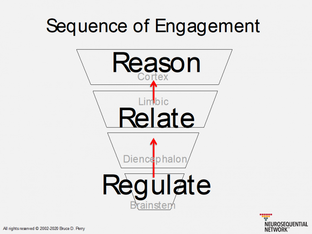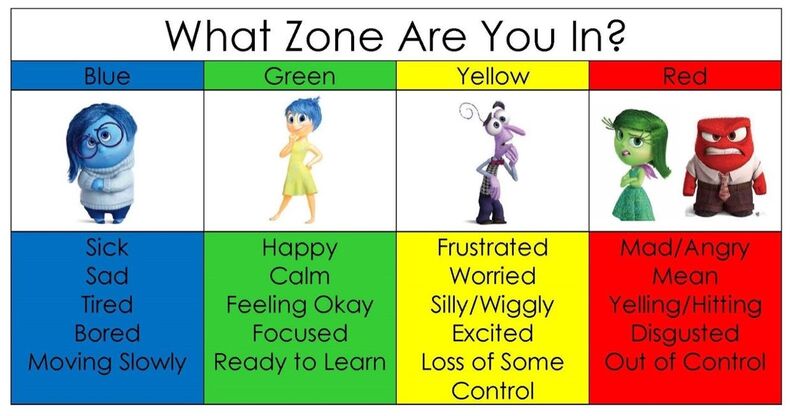
Neurosequential Model in Education
The brain develops and is organized from the bottom up. The functions our brain controls (see the list on the right) start with our basic body functions low in the brainstem and move up to the highest functions in the cortex. All four areas of the brain work in concert with connections from bottom to top and top to bottom.
Until we pay attention to these lower areas and work to bring about healing and new organization, we will struggle with behaviour and healthy relationships. Lower areas are improved by good diet, steady doses of exercise, regular sleep habits, many positive relational interactions, and a steady dosing of patterned, repetitive, rhythmic movements that serve to bring calm and order to a clattering brain.
https://images.pcmac.org/Uploads/ROELaSalle35/ROELaSalle35/Departments/DocumentsCategories/Documents/NME-_Child_Trauma.pdf
The brain develops and is organized from the bottom up. The functions our brain controls (see the list on the right) start with our basic body functions low in the brainstem and move up to the highest functions in the cortex. All four areas of the brain work in concert with connections from bottom to top and top to bottom.
Until we pay attention to these lower areas and work to bring about healing and new organization, we will struggle with behaviour and healthy relationships. Lower areas are improved by good diet, steady doses of exercise, regular sleep habits, many positive relational interactions, and a steady dosing of patterned, repetitive, rhythmic movements that serve to bring calm and order to a clattering brain.
https://images.pcmac.org/Uploads/ROELaSalle35/ROELaSalle35/Departments/DocumentsCategories/Documents/NME-_Child_Trauma.pdf

Here is hierarchy of needs for a successful classroom that educators and parents can agree upon. It all begins with safety. Teachers, students, and parents should expect their school systems to provide a sense of safety for all involved in the education program. Safety comes first.
Once kids and teachers feel safe, there is a chance for engagement. Engagement means keeping students calm and alert...in the learning or engagement zone. To do this requires creativity, a sense of humor, and a classroom run by an instructor who knows when to use transitions and sensory breaks to reengage students who need to be brought back to the learning zone. When students are engaged, they begin to succeed.

When a student is having a difficult time, we know we need to REGULATE first, followed by RELATE (the importance of a strong relationship cannot be overstated!) and lastly, REASON with them about the next steps in learning.

Regulation strategies for school and home:
When learning new ideas or being introduced to a new environment, our brain works best when it's focused and calm. We can use regulation tactics to positively impact our emotional states so that we're focused and ready for learning in any scenario. These strategies refocus our brain via stimulating or quieting practices that generate increased activity in the cortex, where problem solving and emotional regulation occur. Below are some tools that we use at school when children need help transitioning from one activity to another. It may be helpful to incorporate some of our classroom regulation strategies into your family’s daily routine to help make transitions easier.
Body breaks- movement actually “turn on” the brain! Get moving :)
Mind-breaks- meditation practices increase psychological functioning and in the process improve your sense of well-being. Research shows that meditation improves cognition and increases your ability to perform tasks requiring focus.
Breathing techniques that support regulation: https://www.yourtherapysource.com/blog1/2022/01/12/breathing-activities-for-kids-2/
Ten games to practice regulation: https://www.yourtherapysource.com/blog1/2017/05/16/games-practice-self-regulation-skills/
A visual used in many classrooms showing "Zones of Regulation"; students may be prompted "What zone are you in right now?" or offered "How can I help you get back to a more focused brain so we can learn together?"
Resources and services:
Yukon Family Resource Centre 667-3745
Yukon Child & Youth Outreach Groups, 456-3838 to make an intake appointment; 332-7101 for more information
Canadian Mental Health Association Yukon available for telephone or virtual counselling appointments 867-668-6429
KidsHelpPhone 1-800-668-6868
Counselling and crisis support for Indigenous people across Canada, 1-855-242-3310
Related Youtube clips:
Attachment with Your Child - Attachment Parenting with Dr. Gordon Neufeld
Stress, Trauma, and the Brain: Insights for Educators--The Neurosequential Model
Dr Debbie Pushor: Parent and Family Engagement in Education